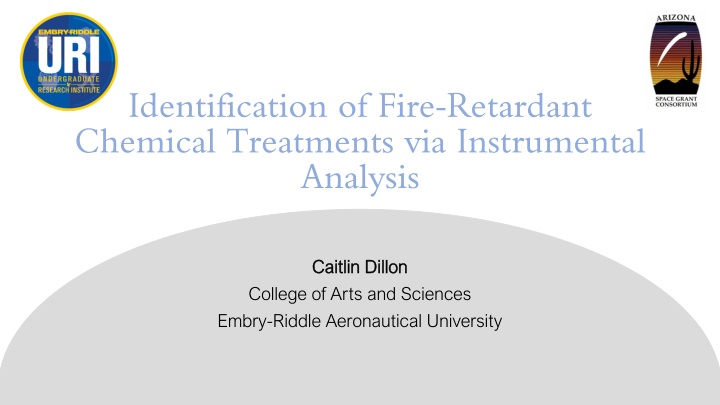
Identification of Fire-Retardant Chemical Treatments in Fiber Samples
Dive into the world of forensic fiber analysis with a focus on identifying fire-retardant chemical residues in fiber samples using instrumental analysis techniques. Follow Caitlin Dillon's research journey at Embry-Riddle Aeronautical University as she develops a method to differentiate fibers based on their flame-retardant compounds. Explore the results of testing various carpet fiber samples from different manufacturers through Fourier-transform infrared spectroscopy, scanning electron microscopy, and gas chromatography mass spectrometry. Uncover the potential for forensic investigators to trace fiber origins and individualize samples through chemical variation analysis.
Download Presentation

Please find below an Image/Link to download the presentation.
The content on the website is provided AS IS for your information and personal use only. It may not be sold, licensed, or shared on other websites without obtaining consent from the author. If you encounter any issues during the download, it is possible that the publisher has removed the file from their server.
You are allowed to download the files provided on this website for personal or commercial use, subject to the condition that they are used lawfully. All files are the property of their respective owners.
The content on the website is provided AS IS for your information and personal use only. It may not be sold, licensed, or shared on other websites without obtaining consent from the author.
E N D
Presentation Transcript
Identification of Fire-Retardant Chemical Treatments via Instrumental Analysis Caitlin Dillon Caitlin Dillon College of Arts and Sciences Embry-Riddle Aeronautical University
Background Fiber trace evidence is one of the most common forms of evidence found at a crime scene Evidentiary fibers often have unique flame retardant compounds that can be used to differentiate fibers Development of an instrumental analysis method to identify fiber manufacturers Forensic method would help to identify individuals from fiber trace evidence and assist in environmental forensic investigations Caitlin Dillon in front of GCMS.
Objective Create a method that forensic investigators can use to determine the origin of fibers using fire-retardant chemical residues. Determine if there is enough chemical variation between fiber samples for identification
Method Test various carpet fiber samples from different manufacturers with a range of carpet qualities and fiber types Fiber samples have been tested using Fourier- transformation infrared spectroscopy (FTIR) and scanning electron microscopy with energy dispersive x-ray spectroscopy (SEM/EDS) Fiber samples have undergone testing using gas chromatography mass spectrometry (GC/MS) using solid-phase microextraction
Results Element Weight Atomic % Element Weight Atomic % C 65.74 71.96 C 61.60 68.21 O 34.09 28.01 O 38.21 31.76 Br 0.17 0.03 Br 0.19 0.03 Figure 1 SEM data from sample DDP Figure 3 SEM data from sample HHP Element Weight Atomic % Element Weight Atomic % C 77.78 82.50 C 75.63 80.69 O 21.62 17.22 O 24.06 19.27 Na 0.31 0.17 Mo 0.30 0.04 S 0.29 0.12 Figure 4 SEM data from sample HHN Figure 2 SEM data from sample DDN
Results Element Weight Atomic % Element Weight Atomic % C 60.77 67.40 C 61.23 67.80 O 39.05 32.52 O 38.68 32.16 Na 0.09 0.05 Al 0.09 0.04 S 0.04 0.02 Ca 0.05 0.02 Figure 5 SEM data from sample RSP Figure 6 SEM data from sample RSPET Scanning electron microscopy used with dispersive x-ray spectroscopy determined that there are fire-retardant chemicals present in samples Gas chromatography mass spectrometry using solid phase microextraction and Fourier-transform infrared spectroscopy testing require more method development
Conclusion Scanning electron microscopy with energy dispersive x-ray spectroscopy determined that fire retardant residue is present on sample fibers Results from gas chromatography mass spectrometry testing using solid phase microextraction support the hypothesis that melt spinning process was used to apply fire-retardant compounds and manufacturers are moving toward applying nonvolatile chemicals on textiles During development of liquid extraction method efficiency, sensitivity, and nondestructive analysis techniques are prioritized
Future Research Continue to test instrumental analysis method using GC/MS with SPME Develop liquid extraction procedure of fire-retardant chemicals from fibers Collect more samples of various quality to test with instrumental analysis methods
Acknowledgements Mentor; Rachael Schmidt Zapata, F., et al. (2022). Spectrochimica Acta Part A:Molecular and Biomolecular Spectroscopy,268, 120695.https://doi.org/10.1016/j.saa.202 1.120695 Dr. Hillary Eaton Grover, T., et al. (2014). Colourage,61, 39- 45+48 Chemistry Department Facilities Alvarez, D. A., et al. (2021). Environmental Toxicology and Chemistry,40(8), 2165 2182.https://doi.org/10.1002/etc.5118 Horn, G. P., et al. (2021). Journal of Occupational and Environmental Hygiene,0(0), 1 15.https://doi.org/10.1080/15459624.202 1.2002343 Dani Carmack
















